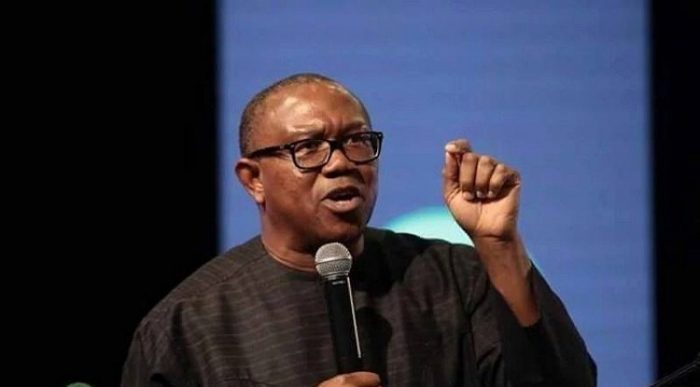Headlines
Notre Dame fire: Macron Promises to Make Cathedral ‘More Beautiful Than Before’

Emmanuel Macron has announced he wants to see Notre Dame cathedral rebuilt “more beautiful than before” within five years, but there are warnings that the repairs could take decades and will involve substantial challenges.
The main problems include the sourcing of materials and painstaking work to preserve elements of the church that have survived the fire but might have been badly damaged by it, experts have warned.
Eric Fischer, who heads a foundation restoring the 1,000-year-old Strasbourg Cathedral that recently underwent a three-year facelift, said he thought rebuilding Notre Dame would probably take several decades.
“The damage will be significant,” Fischer said.
Audrey Azoulay, director-general of Unesco, the UN’ cultural organisation, said restoring Notre Dame “will last a long time and cost a lot of money”.
Donations have poured in from around the world for the restoration efforts, with more than €800m (£692m) pledged as French tycoons and global corporations announced they would donate.
“The fire at Notre Dame reminds us that our history never stops and we will always have challenges to overcome,” Macron said on Tuesday night. “We will rebuild Notre Dame, more beautiful than before – and I want it done in the next five years. We can do it. After the time of testing comes a time of reflection and then of action.”
French authorities revealed on Tuesday that the cathedral was within “15 to 30 minutes” of complete destruction as firefighters battled to stop flames reaching its gothic bell towers.
A greater disaster was averted by members of the Paris fire brigade, who risked their lives to remain inside the burning monument to create a wall of water between the raging fire and two towers on the west facade.
The revelation of how close France came to losing its most famous cathedral emerged as police investigators questioned workers involved in the restoration of the monument to try to establish the cause of the devastating blaze.
Paris prosecutor Remy Heitz said that an initial fire alert was sounded at 6:20pm on Monday evening but no fire was found. The second alert was sounded at 6:43pm, and the blaze was discovered on the roof.
Despite fears at the height of the inferno that the whole cathedral would be lost, the structure appears mainly intact.
Tom Nickson, a senior lecturer in medieval art and architecture at London’s Courtauld Institute, said the stone vault “acted as a kind of fire door between the highly flammable roof and the highly flammable interior” just as the cathedral’s medieval builders intended.
There are fears that the stones of the ceiling and beloved stained glass windows, which survived the blaze, may still have been badly damaged by it. If the stones of the vaulted ceiling have been weakened and cracked by the heat, the whole vault may need to be torn down and re-erected.
The cathedral’s exquisite stained-glass rose windows are probably suffering “thermal shock” from intense heat followed by cold water, said Jenny Alexander, an expert on medieval art and architecture at the University of Warwick. That means the glass, set in lead, could have sagged or been weakened and will need minute examination.
The first challenge for repairers will be to secure the building without disturbing the debris.
“Some of that material may be reusable, and that’s a painstaking exercise. It’s like an archaeological excavation,” said Duncan Wilson, chief executive of the conservation organisation Historic England.
Once the building has been stabilised and the damage assessed, restoration work can begin. It is likely to be an international effort.
“Structural engineers, stained-glass experts, stone experts are all going to be packing their bags and heading for Paris in the next few weeks,” Alexander said.
Financial and political considerations, as well as aesthetic ones, are likely to play a part in the decision about whether to preserve the cathedral as it was before the fire, or adapt it.
Getting materials may also be a challenge. The cathedral roof was made from oak beams cut from centuries-old trees, which were difficult to source even in the 13th century. Nickson said there is probably no country in Europe with big enough trees today.
Then there is the question of conforming to modern-day health and safety standards.
The roof of Strasbourg’s Notre Dame was set ablaze during the 1870 Franco-Prussian War. Nowadays the roof is split into three fire-resistant sections to make sure one blaze can’t destroy it all, with smoke detectors installed are at regular intervals.
“Cathedrals are stone phoenixes reminders that out of adversity we may be reborn,” said Emma Wells, a buildings archaeologist at the University of York.
“The silver lining, if we can call it that, is this allows for historians and archaeologists to come in and uncover more of its history than we ever knew before. It is a palimpsest of layers of history, and we can come in and understand the craft of our medieval forebears.”
Since you’re here…
… we have a small favour to ask. More people are reading and supporting our independent, investigative reporting than ever before. And unlike many news organisations, we have chosen an approach that allows us to keep our journalism accessible to all, regardless of where they live or what they can afford.
The Guardian is editorially independent, meaning we set our own agenda. Our journalism is free from commercial bias and not influenced by billionaire owners, politicians or shareholders. No one edits our editor. No one steers our opinion. This is important as it enables us to give a voice to those less heard, challenge the powerful and hold them to account. It’s what makes us different to so many others in the media, at a time when factual, honest reporting is critical.
Every contribution we receive from readers like you, big or small, goes directly into funding our journalism. This support enables us to keep working as we do – but we must maintain and build on it for every year to come.
Courtesy: The Guardian
Headlines
Renowned Boxer Anthony Joshua Survives Ghastly Road Accident

World-renowned boxer Anthony Joshua on Monday survived a ghastly road accident in Makun, Ogun State.
Eyewitnesses report that the incident occurred along a busy highway of the Lagos-Ibadan expressway.
The vehicle carrying Joshua, a Lexus Jeep with the number plate, KRD 850 HN, reportedly collided with a stationary truck under circumstances that are still being investigated.
Joshua reportedly sustained minor injuries, while two persons were said to have died on the spot.
Headlines
Atiku Warns Against Hasty Re‑gazetting of New Tax Laws

Former Vice President Atiku Abubakar has cautioned that any attempt to hurriedly re‑gazette Nigeria’s new tax laws could undermine parliamentary oversight and set a dangerous constitutional precedent.
Atiku’s warning follows public scrutiny over reports that the Tax Reform Acts signed by President Bola Tinubu differ from the versions passed by the National Assembly. Lawmakers, including Abdussamad Dasuki, raised concerns that the alterations could pose serious legal and constitutional risks, noting that they were not backed by any constitutional framework.
In a statement on X, Atiku said the directive to re-gazette the Acts effectively confirms “that the gazetted version of the Tinubu Tax Act does not reflect what was duly passed by the National Assembly,” calling it “a grave constitutional issue.”
He emphasized that under Section 58 of the 1999 Constitution, a bill only becomes law after passage by both chambers, presidential assent, and gazetting.
“Gazetting is merely an administrative act of publication. It does not create, amend, or validate a law,” Atiku said, adding that any post-passage insertion, deletion, or modification without legislative approval constitutes forgery rather than a clerical error.
Atiku further warned that rushing a re-gazetting while legislative investigations are ongoing “undermines parliamentary oversight and sets a dangerous precedent,” stressing that the only lawful approach is “fresh legislative consideration, re-passage by both chambers, fresh presidential assent, and proper gazetting.”
The former vice president clarified that his position is not opposition to tax reform but a defence of constitutional order.
“This is a defence of the integrity of the legislative process and a rejection of any attempt to normalise constitutional breaches through procedural shortcuts,” he said.
The Federal government has denied wrongdoing, insisting the laws will take effect as scheduled on January 1, 2026, while the National Assembly has directed the issuance of Certified True Copies of the Acts to ensure clarity and accuracy.
Headlines
2027: Aide Confirms Peter Obi’s Imminent Defection to ADC

Barring unforeseen circumstances, the Labour Party (LP) Presidential Candidate in the 2023 elections, Mr. Peter Obi, is set to formally join the African Democratic Congress (ADC) on December 31, 2025.
The development would put to rest months of speculation about where the former Governor of Anambra State would pitch his tent in the coming elections.
Reports claim that Obi would be defecting with serving senators and other lawmakers elected on the platform of the LP, as well as remnants of the Peoples’ Democratic Party (PDP) in the South East region.
Specifically, Obi would be defecting alongside the Senator representing Anambra Central, Victor Umeh; that of Anambra North, Tony Nwoye; Abia South, Enyinnaya Abaribe; PDP chieftain Ben Obi; and members of the Obidient movement in the region.
It is not clear if the Abia State governor, Alex Otti, is part of the planned movement to the ADC.
The governor was recently approached by the PDP to join the party and re-contest his current position in 2027.
Further reports quoted Obi’s spokesperson, Valentine Obienyem, as confirming the planned defection of his boss to the ADC.
“Yes, it is true,” he reportedly said on Sunday.
Senator Umeh said the event would hold in Enugu, adding that it would involve all Obi’s supporters across the South East region.
“They will come from Abia, Anambra, Ebonyi and Imo states to join those in Enugu, where this exercise will hold on 31st December,” he reportedly added.
Sources hinted that Obi, who has not hidden his intention to appear on the ballot in 2027, would contest the presidential ticket of the ADC.
On his part, Chief Chekwas Okorie, reportedly said that the expected formal defection of Obi to the ADC is a healthy development that could reshape the thinking and permutations of the 2027 general elections.
“I imagine that he would be defecting along with most of his associates and followers. I believe that a fortified and strong ADC will add value to the opposition and assuage the general fear of a possible one-party option to Nigerians come 2027. The APC, ADC and possibly the PDP locking horns in the 2027 democratic encounter promises a vibrant and robust electioneering campaign that will provide Nigerians the required options to make informed choices in electing their preferred leaders at all levels. I imagine that the APC leadership will return to the drawing table to map out the strategy to confront the emerging challenge. Nigerians are in interesting times,” Okorie stated.
National President of Njiko Igbo Forum (NIF), Rev Okechukwu Obioha, vouched support for Obi to ensure he reaches the pinnacle of his political career. He, however, cautioned that the ADC should not compromise merit and integrity in the choice of its presidential candidate, stressing that Obi remains the “hope for the restoration of the country on the path of greatness.”






